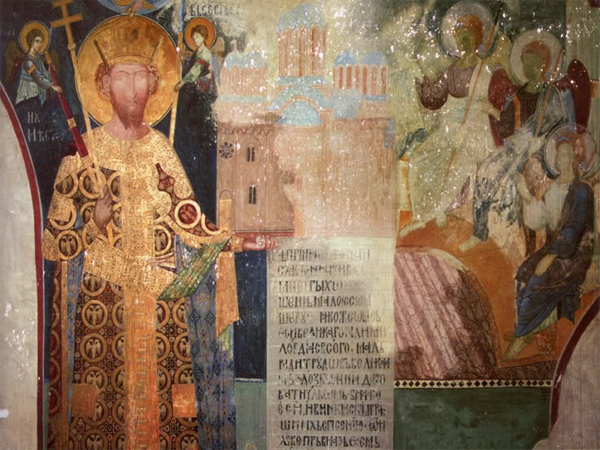
As an Ottoman vassal, Lazarevic was leader of Serbian auxiliary squads in battle of Rovine, Nicopolis and Angora. After the battle of Angora, Lazarevic received, from Byzantines in Constantinople, the title of despot in 1402. In the year 1403-1404 he became ally of Hungarian king Sigismund and received Mačva, Belgrade (which became Lazarevic's capital in 1405), Golubac and other domains, such as Srebrnica in 1411.Stefan II became an ally of the Kingdom of Hungary and a knight of a special order, so when the Hungarian king Sigismund renewed the Order of the Dragon (Societas draconistrarum) in 1408, Despot Stefan Lazarević was the first on the list of members.
After the Ottoman defeat on Angora, civil war erupted in the empire and also clashes among Serbian nobility. First, between Lazarević and Branković, secondly between Stefan and his younger brother Vuk. Clashes in Serbia has ended in 1412, with the conciliation of Stefan and his nephew Đurađ. After the death of Balša III Balšić, he inherited kingdom of Zeta and waged the war against Venetians. Since he didn’t have any children, on the assembly in Srebrnica (1426), Stefan proclaimed his nephew Đurađ Branković as his heir.
On the domestic front, he broke the resistance of the Serbian nobles, and used the periods of peace to strengthen Serbia politically, economically, culturally and military. On 29 January 1412 he issued the "Code of mines" (Законик о рудницима), with a separate section on governing of Novo Brdo – the largest mine in the Balkans at that time. This code increased the development of mining in Serbia, which has been the main economic backbone of Serbian Despotate. At the time of his death, Serbia was one of the largest silver producers in Europe. In the field of architecture, he continued development of Morava school.
He was a great patron of the arts and culture by providing shelter and support to scholars from Serbia, and refugees from neighboring countries that have been taken by the Ottomans. In addition, he was himself a writer, and his most important work is "A Homage to Love," which is characterized by the Renaissance lines. Beside despot’s literature work, in this period there were other authors such as Constantine the Philosopher and Gregory Tsamblak. During his reign Resava school has been formed.
Stefan Lazarević married Jelena in September 1405. Jelena was daughter of Francesco II Gattilusio, Genovesian lord of Lesbos and a sister of Irene Gattilusio, empress of Byzantium empire and a wife of John VII Palaiologos. This marriage was arranged during his stay in Constantinople in 1402, at a time when the city and the Byzantine Empire ruled John VII in the name of his uncle, Manuel II (1373-1391 ruler, Emperor 1391-1425). Jelena and Stefan had no children and Jelena is not shown on any frescoes in monasteries built by Stefan.
